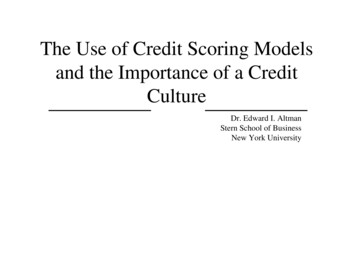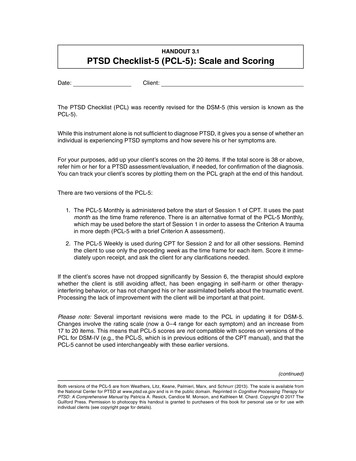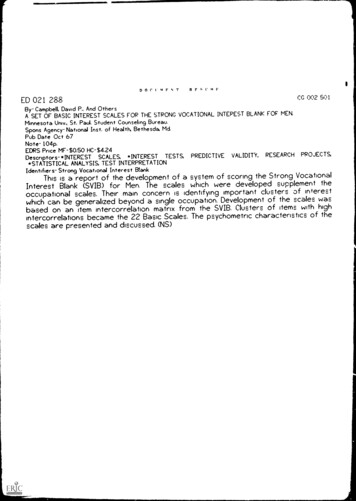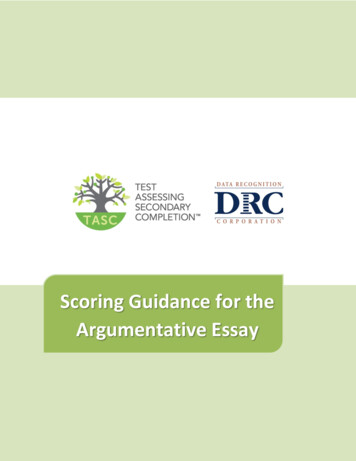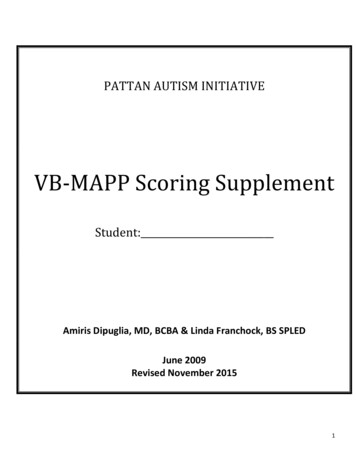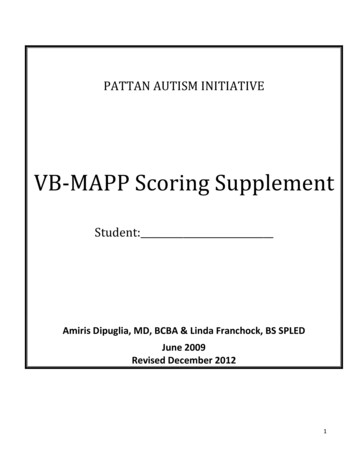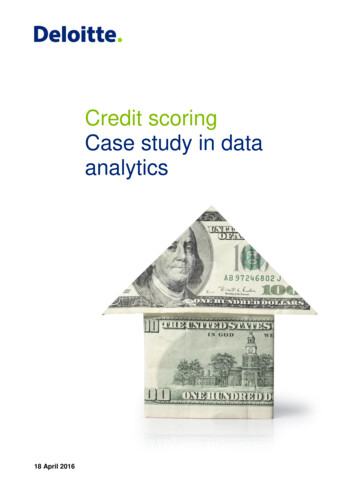
Transcription
Credit scoringCase study in dataanalytics18 April 2016
This article presents some of the keyfeatures of Deloitte’s Data Analyticssolutions in the financial services.As a concrete showcase we outline the mainmethodological steps for creating one of themost common solutions in the industry: Acredit scoring model.We emphasise the various ways to assessmodel performance (goodness-of-fit andpredictive power) and some typicalrefinements that help improve it further.We illustrate how to extract transparentinterpretations out of the model, a holy grailfor the success of a model to the business.Member of Deloitte Touche Tohmatsu Limited
ContentsThe advent of data analytics4Credit scoring5Data quality6Model development7Model performance10Model refinements13Model interpretation15How we can help16Contacts17Credit scoring - Case study in data analytics3
The advent of data analyticsData has the potential to transform business and drive the creation of business value. Data can beused for a range of simple tasks such as managing dashboards or visualising relationships. However,the real power of data lies in the use of analytical tools that allow the user to extract useful knowledgeand quantify the factors that impact events. Some examples include: Customer sentiment analysis,customer churn, geo-spatial analysis of key operation centres, workforce planning, recruiting, or risksensing.Analytical tools are not the discovery of the last decade. Statistical regressions and classificationmodels have been around for the best part of the 20 th century. It is, however, the explosive growth ofdata in our times combined with the advanced computational power that renders data analytics a keytool across all businesses and industries.In the Financial Industry some examples of using data analytics to create business value include frauddetection, customer segmentation, employee or client retention.In order for data analytics to reveal its potential to add value to business, a certain number ofingredients need to be in place. This is particularly true in recent times with the explosion of big data(big implying data volume, velocity and variety). Some of these ingredients are the listed below:Distributed file systemsThe analysis of data requires some IT infrastructure to support the work. For large amounts of data themarket standards are platforms like Apache Hadoop which consists of a component that is responsiblefor storing the data Hadoop Distributed File System (HDFS) and a component responsible for theprocessing of the data MapReduce. Surrounding this solution there is an entire ecosystem of additionalsoftware packages such as Pig, Hive, Spark, etc.Database managementAn important aspect in the analysis of data is the management of the database. An entire ecosystem ofdatabase systems exist: such as relational, object-oriented, NoSQL-type, etc. Well known databasemanagement systems include SQL, Oracle, Sybase. These are based on the use of a primary key tolocate entries. Other databases do not require fixed table schemas and are designed to scalehorizontally. Apache Cassandra for example is designed with the aim to handle big data and have nosingle point of failure.Advanced analyticsAdvanced analytics refers to a variety of statistical methods that are used to compute likelihoods for anevent occurring. Popular software to launch an analytic solution are R, Python, Java, SPSS, etc. Thezoo of analytics methods is extremely rich. However, as data does not come out of some industrialpackage, human judgement is crucial in order to understand the performance and possible pitfalls andalternatives of a solution.Case studyIn this document we outline one important application of advanced analytics. We showcase a solutionto a common business problem in banking, namely assessing the likelihood of a client’s default. This isdone through the development of a credit scoring model.Credit scoring - Case study in data analytics4
Credit scoringA credit scoring model is a tool that is typically used in the decision-making process of accepting orrejecting a loan. A credit scoring model is the result of a statistical model which, based on informationabout the borrower (e.g. age, number of previous loans, etc.), allows one to distinguish between "good"and "bad" loans and give an estimate of the probability of default. The fact that this model can allocatea rating on the credit quality of a loan implies a certain number of possible applications:Application areaDescriptionHealth score:The model provides a score that is related to the probability that the client misses apayment. This can be seen as the “health” of the client and allows the company to monitorits portfolio and adjust its risk.New clientsThe model can be used for new clients to assess what is their probability of respecting totheir financial obligations. Subsequently the company can decide to grant or not therequested loan.What drives defaultThe model can be used to understand what the driving factors behind default are. Thebank can utilise this knowledge for its portfolio and risk assessment.A credit scoring model is just one of the factors used in evaluating a credit application. Assessment bya credit expert remains the decisive factor in the evaluation of a loan.A credit scoring model is just oneof the factors used in evaluatinga credit application. Assessmentby a credit expert remains thedecisive factor.The history of developing credit-scoringmodels goes as far back as the history ofborrowing and repaying. It reflects thedesire to issue an appropriate rate ofinterest for undertaking the risk of givingaway one’s own money.With the advent of the modern statisticsera in the 20th century appropriatetechniques have been developed toassess the likelihood of someone’sdefault on the payment, given theresemblance of his/her characteristics to those who have already defaulted in the past. In thisdocument we will focus on one of the most prominent methods to do credit scoring, the logisticregression. Despite being one of the earliest methods of the subject, it is also one of the mostsuccessful, owing to its transparency.Although credit scoring methods are linked to the aforementioned applications in banking and finance,they can be applied to a large variety of other data analytics problems, such as: Which factors contribute to a consumer’s choice? Which factors generate the biggest impact to a consumer’s choice? What is the profit associated with a further boost in each of the impact factors? How likely is that a customer likes to adopt a new service? What is the likelihood that a customer will go to a competitor?Such questions can all be answered within the same statistical framework. A logistic regression modelcan, for example, provide not only the structure of dependencies of the explanatory variables to thedefault but also the statistical significance of each variable.Credit scoring - Case study in data analytics5
Data qualityBefore statistics can take over and provide answers to the above questions, there is an important stepof preprocessing and checking the quality of the underlying data. This provides a first insight into thepatterns inside the data, but also an insight on the trustworthiness of the data itself. The investigation inthis phase includes the following aspects:What is the proportion of defaults in the data?In order for the model to be able to make accurate forecasts it needs to see enough examples of whatconstitutes a default. For this reason it is important that there is a sufficiently large number of defaultsin the data. Typically in practice, data with less than 5% of defaults pose strong modelling challenges.What is the frequency of values in each variable in the data?This question provides valuable insight into the importance of each of the variables. The data cancontain numerical variables (for example, age, salary, etc.) or categorical ones (education level, maritalstatus, etc.). For some of the variables we may notice that they are dominated by one category, whichwill render the remaining categories hard to highlight in the model. Typical tools to investigate thisquestion are scatterplots and pie charts.What is the proportion of outliers in the data?Outliers can play an important role in the model’s forecasting behaviour. Although outliers representevents that occur with a small probability and a high impact, it is often the case that outliers are a resultof system error. For example, a numerical variable that is assigned to the value 999, can represent acode for a missing value, instead of a true numerical variable. That aside, outliers can be easilydetected by the use of boxplots.How many missing values are there and what is the reason?Values can be missing for various reasons, which range from missing due to nonresponse, due to dropout of the clients, or due to censoring of the answers, or simply missing at random. Missing valuespose the following dilemma: On one hand they refer to incomplete instances of data and thereforetreatment or imputation may not reflect the exact state of affairs. However, avoiding to handle missingvalues and simply ignoring them may lead to loss of valuable information. There exists a number ofways to impute missing values, such as the expectation-maximisation algorithm.Quality assuranceThere is a standard framework around QA which aims to provide a full view on the data quality in thefollowing aspects: Inconsistency, Incompleteness, Accuracy, Precision, Missing / Unknown.Credit scoring - Case study in data analytics6
Model developmentDefault definitionBefore the analysis begins it is important to clearly state out what defines a default. This definition liesat the heart of the model. Different choices will have an impact on what the model predicts. Sometypical choices for this definition include the cases that the client misses three payments in a row, or,that the sum of missed payments exceeds a certain threshold.ClassificationThe aim of the credit scoring model is to perform a classification: To distinguish the “good” applicantsfrom the “bad” ones. In practice this means the statistical models is required to find the separating linedistinguishing the two categories, in the space of the explanatory variables (age, salary, education,etc.). The difficulty in the doing so is (i) that the data is only a sample from the true population (e.g. thebank has records only from the last 10 years, or the data describes clients of that particular bank) and(ii) the data is noisy which means that some of significant explanatory variables may not have beenrecorded or that the default occurred by accident rather than due to the explanatory factors.Reject inferenceApart from this, there is an additional difficulty in the development of a credit scorecard for which thereis no solution: For clients that were declined in the past the bank cannot possibly know what wouldhave happened if they would have been accepted. In other words, the data that the bank has refersonly to customer that were initially accepted for a loan. This means, that the data is already biasedtowards a lower default-rate. This implies that the model is not truly representative for a through-thedoor client. This problem is often termed “reject inference”.Logistic regressionOne of the most common, successful and transparent ways to do the required binary classification to“good” and “bad” is via a logistic function. This is a function that takes as input the client characteristicsand outputs the probability of default.𝑝 exp(𝛽0 𝛽1 𝑥1 𝛽𝑛 𝑥𝑛 )1 exp(𝛽0 𝛽1 𝑥1 𝛽𝑛 𝑥𝑛 )where in the above p is the probability of default xi is the explanatory factor i βi is the regression coefficient of the explanatory factor i n is the number of explanatory variablesFor each of the existing data points it is known whether the client has gone into default or not (i.e. p 1or p 0). The aim in the here is to find the coefficients β0, , βn such that the model’s probability ofdefault equals to the observed probability of default. Typically, this is done through maximumlikelihood.The above logistic function which contains the client characteristics in a linear way, i.e. as 𝛽0 𝛽1 𝑥1 𝛽𝑛 𝑥𝑛 is just one way to make a logistic model. In reality, the default probability will depend on theclient characteristics in a more complicated way.Credit scoring - Case study in data analytics7
Training versus generalisation errorIn general terms, the model will be tested in the following way: The data will be split into two parts. Thefirst part will be used for extracting the correct coefficients by minimising the error between modeloutput and observed output (this is the so-called “training error”).The second part is used for testing the“generalisation” ability of the model, i.e. its ability to give the correct answer to a new case (this is theso-called “generalisation error”).Typically, as the complexity of the logistic function increases (from e.g. linear to higher-order powersand other interactions) the training error becomes smaller and smaller: This means that the modellearns from the examples to distinguish between “good” and “bad”. The generalisation error is,however, the true measure of model performance because it is testing its predictive power. This is alsoreduced as the complexity of the logistic function increases. However, there comes a point where thegeneralisation error stops decreasing (with more examples) with the model complexity and thereafterstarts increasing. This is the point of overfitting. This means that the model has learned to distinguishso well the two categories inside the training data that it has also learned the noise itself. The modelhas adapted so perfectly to the existing data (with all of its inaccuracies) and any new data point will behard to classify correctly.Variable selectionThe first phase in the model development requires a critical view and understanding on the variablesand a selection of the most significant ones. Failure to do so correctly can hamper the model’sefficiency. This is a phase where human judgement and business intuition is critical in the success ofthe model. At first instance, we seek ways to reduce the number of available variables, for example,one can trace categorical variables where the majority of data lies within one category. Other tools fromexploratory data analysis, such as contingency tables, are useful. They could indicate how dominant acertain category is with respect to all others. At a second instance, one can regroup categories ofvariables. The motivation for this comes from the fact that there may exist too many categories tohandle (e.g. postcodes across a country), or certain categories may be linked and not able to standalone statistically. Finally variable significance can be assessed in a more qualitative way by usingPearson’s chi-squared test, the Gini coefficient or the Information Value criterion.Information ValueThe Information Value criterion is based on the idea that we perform a univariate analysis: We setup amultitude of models where there is only one explanatory variable and the response variable (thedefault). Among those models, the ones that describes best the response variable can indicate themost significant explanatory variables.Information Value is a measure of how significant is the discriminatory power of a variable. Its definitionis𝑔𝑖𝑁(𝑥)𝑔𝑖 𝑏𝑖𝑔𝐼𝑉(𝑥) ( ) 𝑙𝑜𝑔 ( )𝑏𝑖𝑔 𝑏𝑖 1𝑏where, N(x) is the number of levels in the variable x gi represents the number of goods (no default) in category i of variable xi bi represents the number of bads (default) in category i of variable xi g represents the number of goods (no default) in the entire dataset b represents the number of bads (default) in the entire datasetTo understand the meaning of the above expression let us go one step further. From the above itfollows ���𝑖𝑔𝑔𝐼𝑉(𝑥) ( ) 𝑙𝑜𝑔 ( ) ( ) 𝑙𝑜𝑔 ( ) 𝐷(𝑔, 𝑏) 𝐷(𝑏, 𝑔)𝑏𝑖𝑏𝑖𝑔𝑏𝑖 1𝑖 1𝑏𝑏Credit scoring - Case study in data analytics8
It is easy to show that 𝐷( , ) is always non-negative using the so-called log-sum inequality:𝑔 𝑖 𝑖𝑔𝑖𝑔) 0𝐷(𝑔, 𝑏) ( ( )) 𝑙𝑜𝑔 (𝑏𝑖𝑔 𝑖 1𝑖 𝑏𝑁 (𝑥 )Since D is non-negative, i.e. D(x,y) 0, with D(x,y) 0 if and only if x y, the quantity D it can be used asa measure of “distance”. Note that this is similar to the Kullback-Leibler distance.To obtain some additional intuition concerning Information Value let us show the following four figures:These represent two hypothetical categorical variables, named x and y. Each of these contains twocategories, say category 1 and category 2. The ratio of “good” vs “bad” is the following:VARIABLE xGOODBADVARIABLE yGOODBADCategory 1 of x70075Category 1 of y55080Category 2 of x30025Category 2 of y45020From this example we notice that the proportion of goods versus bad in the variable x is almost thesame, while in variable y there is a more pronounced difference. Thus we can anticipate the knowledgethat a client belongs to category 1 of x will probably not give away his likelihood of future default, sincecategory 2 of x has the same rate of good vs bad. The contrary with variable y. Computation of theInformation Value of the two variables x and y gives: IV(x) 0.0064 and IV(y) 0.158. Since variable yhas a higher Information Value we say that it has better classification power. Standard practise dictatesthat:Classification powerInformation ValuePoor 0.15ModerateBetween 0.15 and 0.4Strong 0.4It is interesting to see how the same intuition can be obtained from a simple Bayesian argument.Computing the probability of a “good” within a category (say category 1) is:𝑃(𝐺 𝑐𝑎𝑡 1) 𝑃(𝐺, 𝑐𝑎𝑡 1)𝑃(𝑐𝑎𝑡 1 𝐺)𝑃(𝐺) 𝑃(𝑐𝑎𝑡 1)𝑃(𝑐𝑎𝑡 1 𝐺)𝑃(𝐺) 𝑃(𝑐𝑎𝑡 1 𝐵)𝑃(𝐵)Then if 𝑃(𝑐𝑎𝑡 1 𝐺) 𝑃(𝑐𝑎𝑡 1 𝐵) we immediately have that 𝑃(𝐺 𝑐𝑎𝑡 1) 𝑃(𝐺), i.e. no extra informationcan be extracted from this variable.Credit scoring - Case study in data analytics9
Model performanceThe aim of the modelling exercise is to find the appropriate coefficients βi for all i 0,1, ,n that lead to amodel that has two main desirable properties:1. It fits the existing data2. It can produce the correct probability of default on data that it has not seen beforeThe first of these requirements is called “Goodness-of-fit” while the second is called “PredictivePower”. If the data sample is sufficiently large (which it is in our case) the predictive power of themodel is tested out-of-sample which means that we split the data set into a training set (used only formodel development) and a validation set (used only for model testing). We have taken the training /validation split to be at 40%. This means that: 40% of Goods (no-default) are taken as validation data 40% of Bads (default) are taken as validation dataSuch a split should be undertaken with some caution since a totally random split may result in thatsome of the categories in categorical variables are not well-represented.Goodness of FitIf the data contained one response variable (the probability of default) and only one explanatoryvariable then measuring the goodness of fit would be a trivial task: A simple graph would allow us toinspect visually the fit. However since the dimensionality of the dataset is typically very large (of theorder of 50 variables) we have to resort to other methods. The first of these tests is a graph of thefollowing type:Blue dots correspond to the points of the data set. On the x-axis we show the model prediction of theprobability of default (a real number between 0 and 1) while on the y-axis we show the actual observedvalue of default (an integer value of either 0 or 1). Since we cannot easily assess the density of thecloud of points as they overlap each other, we have “smoothed” the above set of data points byconsidering, for each value across the x-axis, an average between those that have observed 0 andthose that have observed 1. The result of this smoothing process is th
Data quality . Credit scoring - Case study in data analytics 7 Default definition . Apart from this, there is an additional difficulty in the development of a credit scorecard for which there is no solution: For clients that were decl


